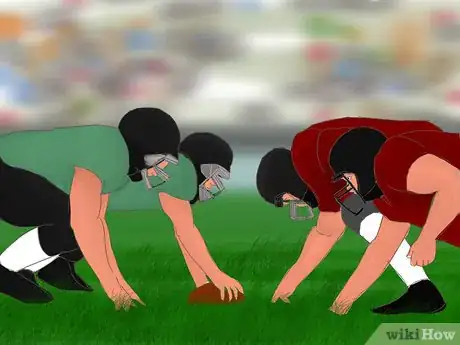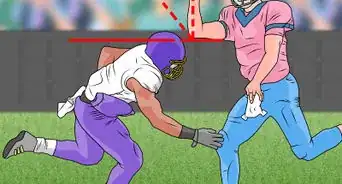This article was co-authored by Felipe Corredor. Felipe is a Senior College Admissions Consultant at American College Counselors with over seven years of experience. He specializes in helping clients from all around the world gain admission into America's top universities through private, one-on-one consulting. He helps guide clients through the entire college admissions process and perfect every aspect of their college applications. Felipe earned a Bachelor's Degree from the University of Chicago and recently received his MBA.
There are 17 references cited in this article, which can be found at the bottom of the page.
wikiHow marks an article as reader-approved once it receives enough positive feedback. In this case, several readers have written to tell us that this article was helpful to them, earning it our reader-approved status.
This article has been viewed 141,769 times.
Playing college football on a full athletic scholarship is a dream for many student-athletes. It can even be a starting point for one day joining the NFL. Though it requires a great deal of planning and preparation, you can get a football scholarship with patience, dedication, and hard work.
Steps
Meeting the Academic and Eligibility Requirements
-
1Start preparing early. Recruiting is a process that takes years and college coaches will often take a look at even freshman athletes. During your first year of high school, talk with your guidance counselor about taking courses that will satisfy the National Collegiate Athletic Association (NCAA) core course requirements. Begin to watch your GPA. And, play the best that you can every game while bonding with your coach.[1]
-
2Take the right classes. To gain NCAA eligibility, you’ll need to complete a set of core courses. For Division I athletes this includes four years of English, three years of Mathematics, two years of Natural Sciences, and other classes as well. Check the NCAA website for your specific requirements and discuss these with your high school guidance counselor.[2]
- The NCAA website also contains a handy pdf worksheet that allows you to track your academic progress on your own. You can also find out more information about how transfer credits figure in to eligibility.
Advertisement -
3Maintain good grades. Colleges are looking for athletes, but also students who can succeed academically and graduate. The GPA requirements for NCAA eligibility are mapped alongside your test scores. So, for example, if your GPA isn’t as good you will need strong ACT or SAT test scores. In contrast, a high GPA can balance out a low test score.[3]
- As an example, a high school athlete looking to land a Division I football scholarship will need a minimum 2.3 GPA to meet minimum eligibility requirements.
- Keeping a strong GPA can also help you to land a combined athletic/academic scholarship package. A little known truth is that many athletes, especially at smaller schools, survive off of mixed scholarships.[4]
-
4Get solid ACT or SAT scores. As mentioned before, your test scores will be placed on a sliding scale alongside your GPA. Try to study for these tests before you take them. You can also take them as many times as you wish in order to get a higher score. But, be aware that you will pay a fee to test each time and to transfer your scores to the NCAA.[5]
- For example, a football player with a 3.55 GPA, who is looking to land at a Division I school, will need a minimum 400 SAT or 37 Sum ACT score for eligibility .[6]
-
5Register with the NCAA. At some point in your sophomore year, go to the online NCAA Eligibility Center (located on the main NCAA website) and complete your college eligibility application. Gather all of your information beforehand as you will need to provide extensive data regarding your personal life, educational life, and sport participation history. You will also need to pay an application fee.[7]
- After you’ve completed your application you can check your status online. Over 90 percent of applicants are determined to be eligible, so your odds are generally good if you’ve followed the basic NCAA rules.
- Some of the choices that can render an athlete ineligible are the following: playing football in a professional league; accepting prize money; getting agent representation; signing a professional contact.[8]
-
6Adhere to NCAA regulations. Be aware that the NCAA can also suspend an eligible athlete with due cause. Consult the NCAA’s Guide for the College-Bound Student-Athlete, available in both printed and online versions, for information on recruiting restrictions. You’ll also want to watch out for ‘moral violations,’ such as drug or alcohol-related arrests.[9]
- Even your campus visits will be subject to NCAA regulation. You must be certified as eligible prior to visiting and the college can only pay for a handful of your expenses, such as transportation.
- For example, you could be considered guilty of a moral violation if you are caught and found guilty of drinking underage. The same goes with any drug-related offenses.
-
7Understand the terms of your scholarship. Once you’ve gotten that golden ticket, your job is not done. You’ll need to work hard in college in order to keep the funds coming in. Some football programs will offer one-year scholarships while others will grant a few multi-year ones as well. Ask lots of questions before signing and closely adhere to the scholarship’s rules while enrolled.[10]
- Ask college officials about how you can use your scholarship monies. Are you able to buy books with these funds? Can it go toward the cost of renting an apartment or just a dorm? Also, find out what happens if you are injured or choose to transfer schools. Does the money disappear or will it continue?[11]
Interacting with College-Level Coaches
-
1Create a list of colleges. When you first decide that you want to play college football, sit down and make a list of the schools that best fit your abilities and interest. Take into account the school’s location, the team’s future potential and history, and the academic offerings. Use this list as the starting point for reaching out to programs and coaches.[12]
- It may be helpful to organize your list according to interest level. Place your top choice program in the #1 position and move down from there. Be prepared to adjust the list over time.[13]
-
2Know the scholarship division levels. As you consider schools you’ll need to decide whether or not to go after a NCAA Division I program or look at a Division II or Division III option. Division I offers the most full-scholarships for football, however, it also the most competitive. Division III, on the other hand, is a good option for student-athletes interested in balancing out academics and sports.[14]
- You can find out more information about these divisions as well as the number of scholarships awarded by going to the NCAA website.
-
3Reach out to college coaches. Call, email, or send a letter to those coaches who direct football programs that are of high interest to you. Introduce yourself and be as specific as you can regarding what attracts you to their program. Get ahold of them as a freshman or sophomore so that you’ll be on their radar later on.[15]
- For example, instead of saying, “I think your program is great,” you might say, “I really admire your consistently high-performing offensive line.”
- Be formal and refer to the coaches by their last name, unless by them told to do otherwise. So, say, “Coach Farris,” or “Mr. Farris.”
-
4Ask your high school coaches for help. Your current coaches can offer suggestions regarding strong and suitable college football programs. They can also contact college coaches to discuss your potential. If other football players from your high school have gone on to play college ball, your coach can reach out to them as well for assistance.[16]
- To approach your coach you might say, “I’m really interested in playing college ball, where do you think I would fit in?”
-
5Know the recruiting calendars. College coaches follow specific rules regarding when, and how, they are able to contact potential students. To more fully understand the recruiting process and make the most of these contacts, go the NCAA website and look over the recruiting calendars posted there. College coaches will also expect you to be informed regarding these rules.[17]
- In the contact period, a college coach will interact with recruits face-to-face and over the phone. In the evaluation period, a college coach may watch the recruit play a game, but will not approach them. In the quiet period, a college coach may not talk to a recruit face-to-face or visit their high school. However, the coach can also call the recruit. In the dead period, a college coach’s contact is severely limited.[18]
-
6Get advice before you commit. When you are presented with a contract, or any paperwork, have your coaches and parents look it over as well. Read all of the fine print to see if there is anything concerning. Look for any areas of possible negotiation as well.
- For example, if a college coach is pressed they may be able to extend a guaranteed scholarship for additional months, such as extending a six-month period into a full year's ride.
-
7Sign a National Letter of Intent. The process of landing a football scholarship will end with you committing to a college and signing an official Letter of Intent. This is a contract between the school and you. They will give you a scholarship in return for you attending their school for at least a year. Most of these contracts are signed by the start of February at the latest.[19]
- If you change your mind and wish to attend a different school be aware that you may lose a full year of eligibility.
- Be cautious with verbal agreements during the recruiting process. A coach may make verbal promises to you, but they are not binding. You may also verbally agree to attend a college, but that statement is not binding either.
Standing Out from the Crowd
-
1Do your best every game. At the end of the day, your athletic prowess is the chief factor determining whether or not you will receive a scholarship. You must play hard every game and you must play as many games are you are able to. Try to be a team player as well in order to show that you will work well with new teammates.
-
2Attend training camps and combines. In the summer before your senior year, if not earlier, make sure to attend as many football camps and showcases (also known as combines) as you can. Try to target those camps sponsored or held by colleges that you are interested in. In some cases you will need to have your coach send in a recommendation for you.
- These camps are also where your “measurables” will be determined. These are personal measurements of your vertical leap, 40-yard dash, and height/weight. Recruiting services, such as ESPN, will post these stats to their main websites.[20]
-
3Make a highlight film. This is a commonly recognized part of the recruiting process for every sport, including football. Put together a video of your best plays. It should be five minutes or less. You can put this together yourself using basic video software. Post the video to YouTube and email the coaches the link.
- College coaches will often ignore videos that last too long or are too elaborate. For example, don’t use slow motion graphics or dramatic music.[21]
- Make sure to include your email on the last frame of the video.
-
4Work with a recruiting company. There are companies and individuals, who you can contact online, who will handle the process of reaching out to college football coaches for you. They will also provide you advice regarding camps, combines, and NCAA regulations. However, be aware that they will charge a fee for these services and it can vary greatly.
- Be aware that some coaches can view recruiters as an unnecessary middleman.[22]
-
5Sign on with a training facility. Search your local area for an athletic training site that specializes in working with professional or pre-professional athletes. These trainers can often offer assistance with reaching out to college coaches. They can also help you to improve your skills which can aid in recruitment as well.[23]
Community Q&A
-
QuestionHow difficult is it to receive an athletic scholarship?
 Community AnswerIt is a very difficult process as less than 2% of high school athletes are offered college-level athletic scholarships at the D1 level. However, you can always try for a combined athletic/academic scholarship or you can consider other levels aside from D2 as well to increase your odds.
Community AnswerIt is a very difficult process as less than 2% of high school athletes are offered college-level athletic scholarships at the D1 level. However, you can always try for a combined athletic/academic scholarship or you can consider other levels aside from D2 as well to increase your odds. -
QuestionAny tips on high school football for a linebacker?
 Community AnswerYou have to know how to read the guards, accelerate and hit the holes when necessary. Play every game like scouts are watching and don't be afraid to ask your coach for advice.
Community AnswerYou have to know how to read the guards, accelerate and hit the holes when necessary. Play every game like scouts are watching and don't be afraid to ask your coach for advice. -
QuestionI'm in my senior year and have only played football this year, is there still a way to be noticed by scouts?
 Community AnswerYes, it is still possible, but you will need to be as aggressive as possible. Work with your college coach and follow the steps described above in order to reach out to college programs. You will also want to get your NCAA clearance as soon as possible.
Community AnswerYes, it is still possible, but you will need to be as aggressive as possible. Work with your college coach and follow the steps described above in order to reach out to college programs. You will also want to get your NCAA clearance as soon as possible.
Warnings
- Don’t sign anything until you are absolutely sure of your decision. You may hear all sorts of verbal promises, but only make your decisions based on what you have on paper.⧼thumbs_response⧽
- Be aware that only 2 percent of high school athletes receive athletic college scholarship monies. And, less than 2 percent of that group go on to play professionally. Make sure to spend time getting a quality education as well.⧼thumbs_response⧽
- Make sure to keep a squeaky clean social media profile. Coaches will often eliminate potential recruits if they see partying or other possible concerns via an online account.[25]⧼thumbs_response⧽
References
- ↑ http://www.ncaapublications.com/productdownloads/EB17.pdf
- ↑ http://fs.ncaa.org/Docs/eligibility_center/DI_and_DII_Worksheet.pdf
- ↑ http://www.ncaapublications.com/productdownloads/EB17.pdf
- ↑ http://usafootball.com/blogs/u.s.-national-team/post/11261/4-ways-to-ruin-your-college-football-scholarship-chances
- ↑ http://www.ncaapublications.com/productdownloads/EB17.pdf
- ↑ http://www.ncaa.org/student-athletes/future/test-scores
- ↑ http://fs.ncaa.org/Docs/eligibility_center/Student_Resources/Registration_Checklist.pdf
- ↑ http://www.ncaa.org/student-athletes/future/amateurism
- ↑ http://www.ncaapublications.com/productdownloads/CBSA17.pdf
- ↑ http://www.ncaa.org/about/frequently-asked-questions-about-ncaa
- ↑ http://www.ncaa.org/student-athletes/future/scholarships
- ↑ http://www.stack.com/a/football-scholarship
- ↑ http://www.active.com/academic/articles/8-steps-to-getting-recruited
- ↑ http://www.athleticscholarships.net/footballscholarships.htm
- ↑ http://usafootball.com/blogs/u.s.-national-team/post/11261/4-ways-to-ruin-your-college-football-scholarship-chances
- ↑ http://www.huffingtonpost.com/kai-sato/5-keys-to-landing-a-college-football-scholarship_b_6273030.html
- ↑ http://www.ncaa.org/student-athletes/resources/recruiting-calendars/2016-17-division-i-and-ii-recruiting-calendars
- ↑ http://www.ncaa.org/student-athletes/future/recruiting
- ↑ http://www.ncaa.org/student-athletes/future/recruiting
- ↑ http://www.clarionledger.com/story/sports/recruitingreport/2016/01/30/cost-getting-recruited/79563374/
- ↑ http://usafootball.com/blogs/u.s.-national-team/post/11261/4-ways-to-ruin-your-college-football-scholarship-chances
- ↑ http://www.cbsnews.com/news/8-things-you-should-know-about-sports-scholarships/
- ↑ http://usafootball.com/blogs/u.s.-national-team/post/11261/4-ways-to-ruin-your-college-football-scholarship-chances
- ↑ http://www.ncaa.org/student-athletes/future/amateurism
- ↑ http://www.huffingtonpost.com/kai-sato/5-keys-to-landing-a-college-football-scholarship_b_6273030.html
About This Article
To optimize your chances of getting a football scholarship, start training early in high school. Maintain both your body and grades, as a student athlete needs athleticism and a solid GPA to attend a good college. Register with the NCAA as a sophomore, and talk to your guidance counselor about the classes required for their scholarship eligibility. When you're ready, reach out to college coaches about why specifically you're interested in their programs. Keep reading to find out how to stand out to college coaches and recruiters at practice!


















































































